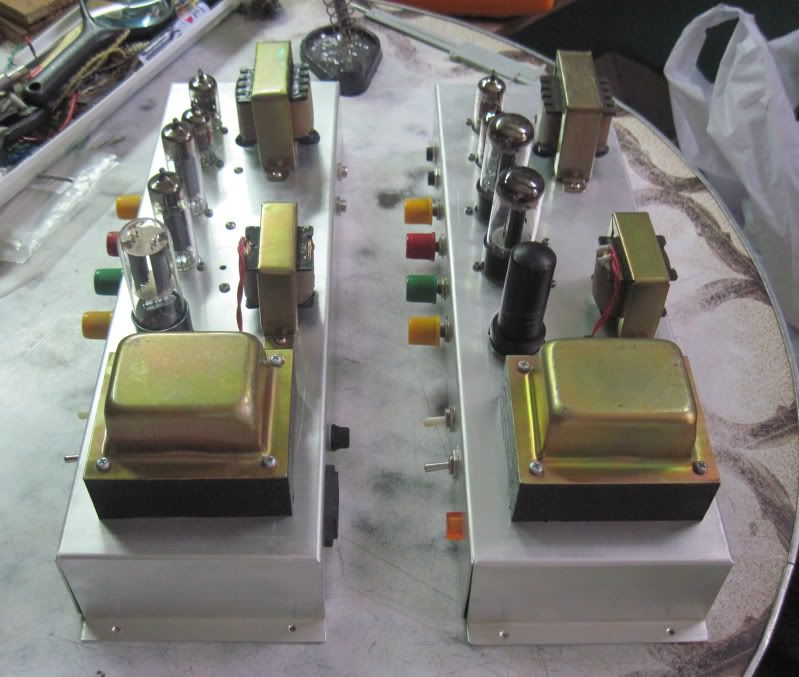YouTube - Laney CUB 8 single ended class A all tube guitar amp demo
Laney is a big-league player, there are many boutique's letting SE out from now on!
And let' be clear: Real Class-A is ONE output-device ruling over both pos and neg side!!!!
Laney is a big-league player, there are many boutique's letting SE out from now on!
And let' be clear: Real Class-A is ONE output-device ruling over both pos and neg side!!!!
Last edited:
If the tubes are upside down they have a tendency to fall off
This comes from a personal email from Joe Rosen - he explains it better
"There is another problem with 9-pin power valves, one that nobody seems to talk about. The valves don't have as much glass to radiate the heat through like the bigger octal valves, and EL84's need substantial bias currents.
So the valve pins really heat up. What this does, apart from speeding oxidation/corrosion of the socket contacts (and 9-pin valves aren't this proper nickel material like the better octal sockets, but rather are this nasty cadmium-plated or worse, silver-plated ****), is that the heat seems to temper the metal alloy. After about a year, two at the most (call it 1000 hours), the sockets open up from the heat stress and mechanical forces on them to the point where they become so loose, that you can literally TURN THE AMPLIFIER UPSIDE DOWN AND THE OUTPUT VALVES WILL FALL OUT!!!!"
Of course in a Vox like amp you don't have to turn the amp upside down for this to happen.
I don't think your numbers are correct firechief (1 Watt), but not interested in discussing this.
Point to point is highly overated. We are talking consumer electronics here.
Boy now that statement will stir up some reaction!
Boy now that statement will stir up some reaction!
This comes from a personal email from Joe Rosen - he explains it better
"There is another problem with 9-pin power valves, one that nobody seems to talk about. The valves don't have as much glass to radiate the heat through like the bigger octal valves, and EL84's need substantial bias currents.
So the valve pins really heat up. What this does, apart from speeding oxidation/corrosion of the socket contacts (and 9-pin valves aren't this proper nickel material like the better octal sockets, but rather are this nasty cadmium-plated or worse, silver-plated ****), is that the heat seems to temper the metal alloy. After about a year, two at the most (call it 1000 hours), the sockets open up from the heat stress and mechanical forces on them to the point where they become so loose, that you can literally TURN THE AMPLIFIER UPSIDE DOWN AND THE OUTPUT VALVES WILL FALL OUT!!!!"
Of course in a Vox like amp you don't have to turn the amp upside down for this to happen.
I don't think your numbers are correct firechief (1 Watt), but not interested in discussing this.
Cassiel, I have been on the road for nearly fouty years gigging with Fender blackface amps where the socket-clamps just kissed the 6L6's - and the stress from the G's in the road-cabs on the way to the next was intimidating. No problems!
Peter
Pete, 8-pin sockets are a different story. My 6v6's stay in place. I'm talking about 9 pins sockets.
The current through the common cathode resistor is I=11.2/120 or 93.3 ma, devided by two is 46.7 ma per tube. I think thats not so bad. If p=.046 X 348 then each tube is disapating 16.0 W ---- I would like to hear from other on this because I have thoughts of trying a EL84 guitar amp.
maximum ratings for the EL84 are 12watts plate dissipation and 300volts plate...if you stay outside this limits, expect short lived tubes...
Actually, real Class-A guitar amps are being very popular among jazz-guitarists with carved-top acoustic/electrics.
Peter
classA means single ended topology, push-pulls always end up as classAB......
this is a single ended 5F1 clone is finished just the other day...

Last edited:
there are spitfire clones,
one using 12W6 finals and the other EL84's
Hey-hey Tony, which one do you prefer?
Hey-hey Tony, which one do you prefer?
not me, but the guitarist who commissioned me to make the amps chose the 12W6 over the EL84's......to my surprise....😀
even my son liked the 12W6 over the EL84.....
the 12W6 is just like the 6V6, though with lower plate voltage and lower still screen grid ratings....
Last edited:
Can anyone tell me what the design concept is with the master 1M pot in the schematic in the first post? The pot is installed between the grids of the output devices. Does this not mean that one extreame setting its shorting the two grids together AC wise? I would think that this configuration stops working like a push pull amp at some point. Sure the volume is going to decrease, and there is no DC reason why it cant be done, but its either a clever idea, or just crazy.
OK Tony thanks for the comment. Im all for simple ways of getting from here to there. I might copy this idea😉
- Status
- Not open for further replies.
- Home
- Live Sound
- Instruments and Amps
- Matchless spitfire el84 dissipation

